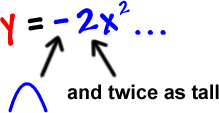As we saw in the previous lessons, when a parabola is in the form
![]()
it's pretty easy to graph.
The only problem is... They usually aren't in this form! (D'oh.)
You might need to graph something like this:

Well, we can see by the ![]() that this IS a parabola...
that this IS a parabola...
and that it will be upside down

But, other than that, it's impossible to tell.
The "+ 4x + 1" part means that there's some sort of shifting going on, but we can't see what it is.
We'll need some way to get this thing in our easy graphing form:
![]()
The amazing trickery that will get our desired result is called completing the square. It's not too bad, once you get used to it.